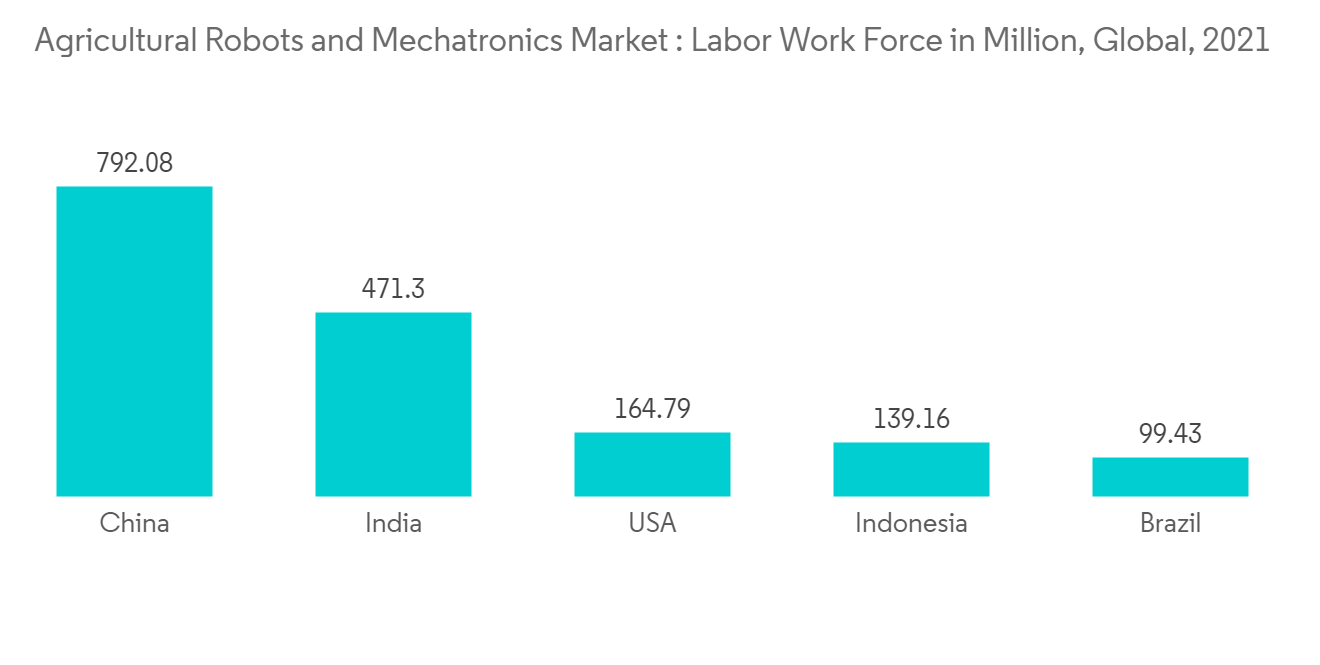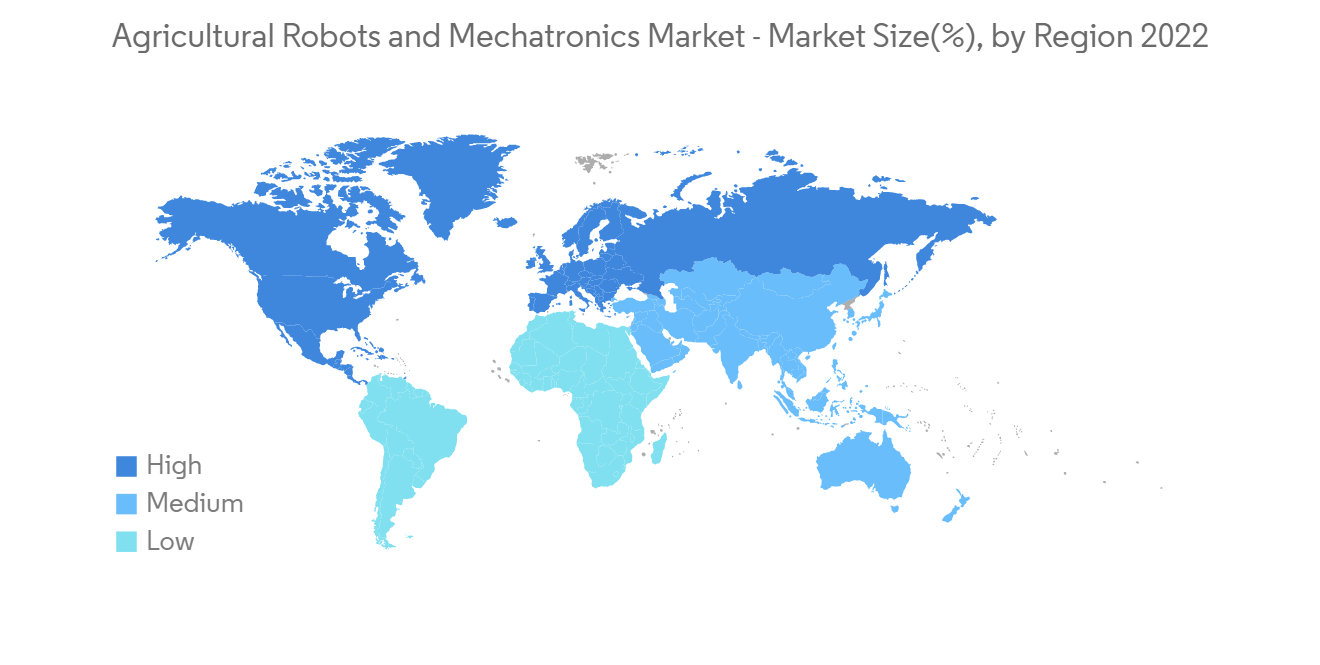 |
市场调查报告书
商品编码
1272673
农业机器人和机电一体化市场——增长、趋势和预测 (2023-2028)Agricultural Robots and Mechatronics Market - Growth, Trends, and Forecasts (2023 - 2028) |
||||||
※ 本网页内容可能与最新版本有所差异。详细情况请与我们联繫。
在预测期内,全球农业机器人和机电一体化市场预计将以 20.4% 的复合年增长率增长。
主要亮点
- 机器人技术将彻底改变农业。 但看看农民、农业企业和消费者如何利用机器人技术和数字机械化的力量来塑造这个行业的未来,将会很有趣。 食品需求的增长和城市化进程的加快是全球农业机器人市场的主要增长因素。 各国政府推出了几项全球有益的政策,以提高认识和提高产量。 例如,欧盟正在资助用先进的自动化技术取代劳动密集型工作的项目。 这有望在一定程度上带动农业机器人和机电一体化市场。
- 移动机器人有望取代半熟练工人。 但自动化农场永远不会存在。 农民、牧场主和农学家仍然需要做出决定。 另一方面,有一些适合机器的农业工作。 因此,需要提高劳动力素质以应对高科技机械。 在日本,政府正在大力投资农业机器人并提高工人的技能水平。 结果是工人的工资更高,农村地区的生活质量更好。
- 推动这个市场增长的主要因素是劳动力短缺、劳动力成本上升、对食品和农业供应的需求增加、工作效率提高、新兴技术的采用、最终结果完美的人力劳动。越来越多的研究进入各种应用程序,使生活更轻鬆。 这就是对未来几年市场增长的预测。
农业机器人和机电一体化的市场趋势
劳动力短缺和高成本驱动市场
农业机器人是用于提高作物质量和效率、最大限度地减少对体力劳动的依赖并提高整体生产力的自主机器。 例如,在园艺和水果采摘方面,机器人平台上的工人效率是梯子上工人的两倍。 采摘者短缺已经导致世界上超过 10% 的水果和蔬菜未在田间和果园收穫。 这与欧盟的年消费量相当。 对于经常受劳动力可用性影响的行业,机器人可能是一个可行的解决方案,为现代劳动力创造广泛的就业机会。 根据国际劳工组织 (ILO) 的数据,发展中国家的农业工人比例已从 81% 下降至 48.2%。 发达国家也不例外,降幅如此之大。
世界政府峰会与奥纬咨询合作发布了一份题为“农业 4.0 - 农业技术的未来”的报告。 报告称,应对这些挑战需要政府、投资者和创新农业技术的共同努力。 农业 4.0 不再依赖于在田间均匀撒施水、化肥和农药。 相反,农民和农业经营将由传感器、设备、机器和信息技术来管理。 未来的农业将由机器人、温度和湿度传感器、航空影像和 GPS 技术等先进技术驱动。 这些先进的设备、精准农业和机器人系统将使农场更有利可图、更高效、更安全、更环保。 这将推动预测期内市场的增长。
2022 年,BT 将投资于农业自动化和可持续发展,以开发新的方法来实现软果种植业的自动化,从而降低成本和劳动力,同时推进机器人技术和自主解决方案。推出新的机器人平台和管理系统以推动潜力和运营效率,提供传感器技术来监测作物健康和预测潜在问题,在问题发生之前进行干预,并帮助农民避免食物浪费和更多不必要的劳动,提供将在未来几年促进市场发展的功能。 基于上述情况,农业机器人和机电一体化市场有望在预测期内蓬勃发展。

北美主导全球市场
北美之所以能够占据这个位置,很大程度上是美国无人机市场的结果。 美国是目前农业领域无人机部署最多的国家。 美国的农场已经在使用无人机执行各种农业任务,包括农药喷洒、作物监测、播种和灌溉管理。 在部署无人机和自动驾驶汽车方面,我们处于该领域的前沿。 在农业领域,机器人技术的应用越来越多。 因此,技术进步正在推动全球农业机器人市场的增长。
机器人技术正在以前所未有的方式推动世界向前发展。 在过去十年中,机器人工具的进步使微创外科手术成为可能,探索机器人增强了人类在行星系统中的存在,机器人车辆自主行驶了数百万英里,製造机器人推动美国成为先进製造业的领导者. 联邦政府认为,确保正确的劳动力过渡,包括 STEM 教育、培训计划和现有工人的再培训以满足未来劳动力需求,将对美国整体经济产生重大影响。我们对未来的既得利益机器人产业。
2022年,Nio Technology将结合尖端机器人技术和人工智能技术,创造一种新的除草剂替代品,它可以保护土壤、改善工作条件并为智能农业收集数据。农业机器人“Orio”发布。 Orio 还有一个标准的 3 点附件,可以让您将任何仪器安装在机器人的后部。 例如,精准播种是 Orio 为种植者提供的一项附加服务,可以与除草相结合以获得更好的效果。 该公司最近在 CES 2022 上推出了葡萄园机器人 Ted。
在北美,大规模农业、劳动力下降和农业生产力提高是推动市场发展的主要因素。 在加拿大等国家,通过有效利用技术和现代设备实现的成本降低是主要驱动力,从而导致作物产量和质量的全面提高。

农业机器人及机电一体化产业概况
全球农业机器人和机电一体化市场较为分散,前九大公司占比不到 30-35%。 与此同时,其他公司占据了剩余的份额。 市场上的主要参与者是雅马哈汽车公司、GEA Group Aktiengesellschaft、DeLaval Inc.、Dere and Company(美国)、AGCO Corporation 等。 一些公司正在迅速增加他们在市场上的存在。
其他福利:
- Excel 格式的市场预测 (ME) 表
- 3 个月的分析师支持
内容
第一章介绍
- 调查假设和市场定义
- 本次调查的范围
第二章研究方法论
第 3 章执行摘要
第四章市场动态
- 市场概览
- 市场驱动因素
- 市场製约因素
- 波特的五力分析
- 供应商的议价能力
- 买方/消费者议价能力
- 新进入者的威胁
- 替代品的威胁
- 竞争公司之间的敌对关係
第 5 章市场细分
- 类型
- 自动拖拉机
- 无人驾驶飞行器 (UAV)
- 挤奶机器人
- 其他类型
- 用法
- 作物生产
- 畜牧业
- 森林管理
- 其他用途
- 地区
- 北美
- 美国
- 加拿大
- 墨西哥
- 其他北美地区
- 欧洲
- 西班牙
- 英国
- 法国
- 德国
- 俄罗斯
- 意大利
- 其他欧洲
- 亚太地区
- 中国
- 印度
- 日本
- 澳大利亚
- 其他亚太地区
- 南美洲
- 巴西
- 阿根廷
- 其他南美洲
- 中东和非洲
- 南非
- 其他中东和非洲地区
- 北美
第6章竞争格局
- 最常采用的策略
- 市场份额分析
- 公司简介
- AgEagle Aerial Systems
- Autonomous Solutions(ASI)
- Autonomous Tractor Corporation
- AutoProbe Technologies
- BouMatic Robotics
- Clearpath Robotics Inc.
- Conic System
- Tetra Laval(DeLaval Inc.)
- EcoRobotix Ltd
- GEA Group Aktiengesellschaft
- Harvest Automation Inc.
- Deere & Company
- Lely Industries N.V.
- Naio Technologies
- PrecisionHawk
- A/S S. A. Christensen & Co.(SAC Milking)
- SenseFly
- Vision Robotics Corporation
- Vitirover
- Wall-Ye
- Yamaha Motor Co. Ltd
第7章 市场机会与将来动向
The global agricultural robots and mechatronics market are anticipated to grow at a CAGR of 20.4% during the forecast period.
Key Highlights
- Robotics will bring the agricultural revolution. However, it would be interesting to see how the farmers, agri-businessmen, and consumers will utilize the power of robotics and digital mechanization to shape the future of this industry. The growing demand for food and increasing urbanization are among the major growth drivers of the global agricultural robot market. Governments have launched several beneficial policies globally to improve awareness and enhance yields. For instance, the European Union has funded projects to replace labor-intensive tasks with advanced automated technologies. This is likely to drive the agricultural robots and mechatronics market to an extent.
- Mobile robots will replace semi-skilled workers. However, there is never going to be an automated farm. There is still a need for farmers, farm managers, and agronomists people to make decisions. On the other hand, some agricultural tasks are better suited for machines. So we will require an increased workforce quality to deal with high-tech machines. In Japan, The government there is investing a lot of money in agricultural robotics to increase the workers' skill level. This, in turn, increases the workers' pay and the quality of life in rural areas.
- The key factors propelling this market's growth are labor shortage, increasing labor cost, increasing demand for food and agriculture supply, the efficiency of work, adoption of emerging technologies, and increasing research on different applications to make human life easier with perfect end results. This will anticipate the growth of the market during the coming years.
Agricultural Robots and Mechatronics Market Trends
Shortage and Cost of Labor is Driving the Market
Agricultural robots are autonomous machines used to improve crop quality and efficiency, minimize reliance on manual labor and increase overall productivity. For example, workers on robotic platforms in horticulture and fruit picking are twice as efficient as workers using ladders. The shortage of pickers is already causing more than 10% of fruits and vegetables worldwide to be left unpicked in fields and orchards. This is equivalent to annual consumption in the European Union. Robots may be a viable solution for an industry frequently impacted by labor availability, and they will create different employment opportunities in a modern workforce. According to International Labor Organization(ILO), the agricultural labor percentage of the workforce declined from 81% to 48.2% in developing countries. Also, developed countries are not an exception in such a huge decline.
The World Government Summit launched a report called Agriculture 4.0 - The Future of Farming Technology in collaboration with Oliver Wyman. The report states that meeting these challenges will require a concerted effort by governments, investors, and innovative agricultural technologies. Agriculture 4.0 will no longer depend on applying water, fertilizers, and pesticides uniformly across entire fields. Instead, farmers, agricultural operations will run on sensors, devices, machines, and information technology. Future agriculture will use sophisticated technologies such as robots, temperature and moisture sensors, aerial images, and GPS technology. These advanced devices, precision agriculture, and robotic systems will allow farms to be more profitable, efficient, safe, and environmentally friendly. This will boost the growth of the market during the forecast period.
In 2022, BT unveiled a new robotics platform and management system to automate the agricultural industry and drive sustainability and operational efficiencies to develop novel ways of automating the soft fruit farming industry in ways that will cut costs and labor while promoting robotic and autonomous solutions and offers features sensor technology to monitor crop health and forecast potential issues, helping farmers to intervene before a problem arises, and avoid food waste and unnecessary labor further down the line and which will drive the market in coming years. Owing to the above factors, the market for agricultural robotics and mechatronics is expected to boom during the forecast period.

North America Dominates the Global Market
North America has this position mostly as a result of the US drone market. Currently, the United States is the country that has adopted drones the most in the agricultural industry. Farms are already using drones in the United States for various agricultural tasks, such as pesticide spraying, crop monitoring, sowing, irrigation control, and more. In terms of the deployment of drones and autonomous cars, they are at the forefront of the sector. Robotics is being used in an increasing number of applications in the agricultural space. As such, technological advances are driving growth in the global agricultural robot market.
Robotics is driving the world forward in ways previously unimaginable. In the past decade, advances in robotic tools have enabled less invasive surgical procedures, exploration robots have enhanced human presence in planetary systems, robotic vehicles have autonomously driven millions of miles, and manufacturing robotics have positioned the United States as a leader in advanced manufacturing. The Federal government has a vested interest in the future of the US robotics industry as it will greatly affect the overall US economy to ensure proper workforce transition, including in STEM education, training programs, and re-skilling current workers, so they are prepared to meet future workforce needs.
In 2022, Naio Technologies introduced a new Orio agricultural robot alternative to herbicides that respects soils, improves working conditions, and collects data for smart farming by combining high-edge technology in robotics and AI. Orio can also have a standard three-point attachment and carry any implement at the robot's rear. For instance, high-accuracy seeding is an additional service Orio provides to growers allowing enhanced results when combined with weeding. The company recently released its vineyard robot Ted during CES 2022.
The major factors driving the market studied in North America are large-scale farming operations, the decline in labor, and the need to enhance the productivity of agriculture. In countries like Canada, major driving factors are cost savings achieved through efficient utilization of technology and modern equipment, leading to an overall increase in yield and quality of the crops.

Agricultural Robots and Mechatronics Industry Overview
The global agricultural robots and mechatronics market is moderately fragmented, with the top nine companies accounting for less than 30-35%. In contrast, the rest of the companies account for the remaining share. The major players in the market are Yamaha Motor Company, GEA Group Aktiengesellschaft, DeLaval Inc., Deere and Company (US), and AGCO Corporation, among others. Several companies are rapidly expanding their market presence.
Additional Benefits:
- The market estimate (ME) sheet in Excel format
- 3 months of analyst support
TABLE OF CONTENTS
1 INTRODUCTION
- 1.1 Study Assumptions & Market Definition
- 1.2 Scope of the Study
2 RESEARCH METHODOLOGY
3 EXECUTIVE SUMMARY
4 MARKET DYNAMICS
- 4.1 Market Overview
- 4.2 Market Drivers
- 4.3 Market Restraints
- 4.4 Porter's Five Force Analysis
- 4.4.1 Bargaining Power of Suppliers
- 4.4.2 Bargaining Power of Buyers/Consumers
- 4.4.3 Threat of New Entrants
- 4.4.4 Threat of Substitute Products
- 4.4.5 Intensity of Competitive Rivalry
5 MARKET SEGMENTATION
- 5.1 Type
- 5.1.1 Autonomous Tractors
- 5.1.2 Unmanned Aerial Vehicles (UAVs)
- 5.1.3 Milking Robots
- 5.1.4 Other Types
- 5.2 Application
- 5.2.1 Crop Production
- 5.2.2 Animal Husbandry
- 5.2.3 Forest Control
- 5.2.4 Other Applications
- 5.3 Geography
- 5.3.1 North America
- 5.3.1.1 United States
- 5.3.1.2 Canada
- 5.3.1.3 Mexico
- 5.3.1.4 Rest of North America
- 5.3.2 Europe
- 5.3.2.1 Spain
- 5.3.2.2 United Kingdom
- 5.3.2.3 France
- 5.3.2.4 Germany
- 5.3.2.5 Russia
- 5.3.2.6 Italy
- 5.3.2.7 Rest of Europe
- 5.3.3 Asia-Pacific
- 5.3.3.1 China
- 5.3.3.2 India
- 5.3.3.3 Japan
- 5.3.3.4 Australia
- 5.3.3.5 Rest of Asia-Pacific
- 5.3.4 South America
- 5.3.4.1 Brazil
- 5.3.4.2 Argentina
- 5.3.4.3 Rest of South America
- 5.3.5 Middle East and Africa
- 5.3.5.1 South Africa
- 5.3.5.2 Rest of Middle East and Africa
- 5.3.1 North America
6 COMPETITIVE LANDSCAPE
- 6.1 Most Adopted Strategies
- 6.2 Market Share Analysis
- 6.3 Company Profiles
- 6.3.1 AgEagle Aerial Systems
- 6.3.2 Autonomous Solutions (ASI)
- 6.3.3 Autonomous Tractor Corporation
- 6.3.4 AutoProbe Technologies
- 6.3.5 BouMatic Robotics
- 6.3.6 Clearpath Robotics Inc.
- 6.3.7 Conic System
- 6.3.8 Tetra Laval(DeLaval Inc.)
- 6.3.9 EcoRobotix Ltd
- 6.3.10 GEA Group Aktiengesellschaft
- 6.3.11 Harvest Automation Inc.
- 6.3.12 Deere & Company
- 6.3.13 Lely Industries N.V.
- 6.3.14 Naio Technologies
- 6.3.15 PrecisionHawk
- 6.3.16 A/S S. A. Christensen & Co. (SAC Milking)
- 6.3.17 SenseFly
- 6.3.18 Vision Robotics Corporation
- 6.3.19 Vitirover
- 6.3.20 Wall-Ye
- 6.3.21 Yamaha Motor Co. Ltd













